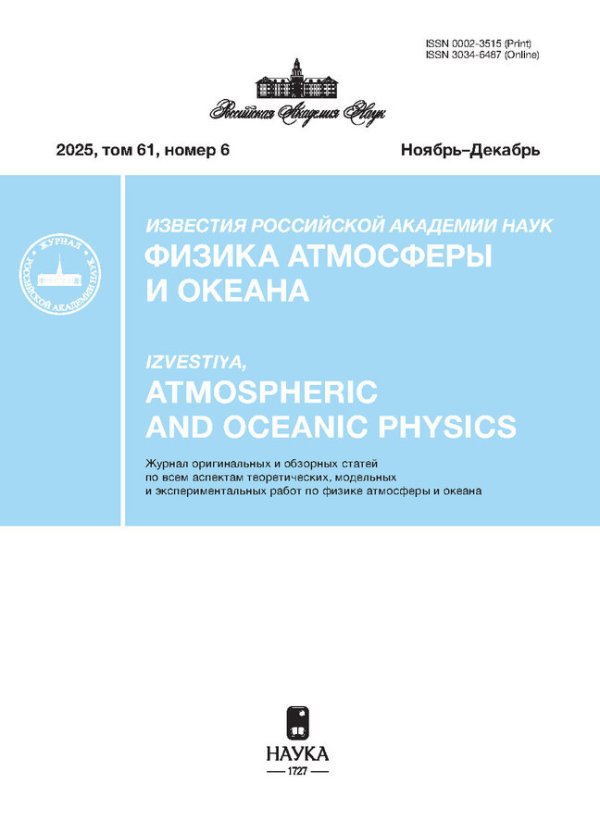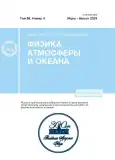Changes in the Oxygen Content in Urban Air under the Influence of Natural and Anthropogenic Factors
- Authors: Ginzburg A.S.1, Vinogradova A.A.1, Lezina E.A.2, Pomelova M.A.1,3
-
Affiliations:
- Obukhov Institute of Atmospheric Physics, Russian Academy of Sciences
- Budgetary Environmental Protection Institution “Mosecomonitoring”
- Vavilov Institute for the History of Science and Technology, Russian Academy of Sciences
- Issue: Vol 59, No 4 (2023)
- Pages: 437-449
- Section: Articles
- URL: https://journals.rcsi.science/0002-3515/article/view/136929
- DOI: https://doi.org/10.31857/S0002351523040065
- EDN: https://elibrary.ru/YNGQLA
- ID: 136929
Cite item
Full Text
Abstract
The article analyzes the results of measuring the oxygen content in Moscow in 2017–2021 at three automatic stations for monitoring atmospheric pollution of the “Mosecomonitoring”. Seasonal variations of oxygen content in the city are considered, the issues of compliance of the obtained values with the scale of comfort level for human breathing developed by medical specialists are discussed, measurement data are compared with the results of calculating the oxygen concentration in the air by the magnitude of meteorological parameters. According to the measurements, diurnal variations of the O2 content in the surface urban air, more pronounced in the warm season, were revealed. The minimum O2 content is observed in summer in the early morning hours. The main natural and anthropogenic processes that determine the variability of oxygen content in the surface air of a megalopolis at different time scales are discussed.
About the authors
A. S. Ginzburg
Obukhov Institute of Atmospheric Physics, Russian Academy of Sciences
Email: gin@ifaran.ru
Russia, 119017, Moscow, Pyzhevsky per., 3
A. A. Vinogradova
Obukhov Institute of Atmospheric Physics, Russian Academy of Sciences
Email: gin@ifaran.ru
Russia, 119017, Moscow, Pyzhevsky per., 3
E. A. Lezina
Budgetary Environmental Protection Institution “Mosecomonitoring”
Email: gin@ifaran.ru
Russia, 121019, Moscow, Novy Arbat str., 11/1
M. A. Pomelova
Obukhov Institute of Atmospheric Physics, Russian Academy of Sciences; Vavilov Institute for the History of Science and Technology, Russian Academy of Sciences
Email: gin@ifaran.ru
Russia, 119017, Moscow, Pyzhevsky per., 3; Russia, 125315, Moscow, Baltiyskaya ul., 14
References
- Башкин В.Н. Биогеохимия. М.: Научный мир, 2004. 584 с.
- Гинзбург А.С., Виноградова А.А., Федорова Е.И., Никитич Е.В., Карпов А.В. Содержание кислорода в атмосфере крупных городов и проблемы дыхания // Геофизические процессы и биосфера. 2014. Т. 13. № 2. С. 5–19.
- Гинзбург А.С., Виноградова А.А., Помелова М.А. Современные изменения содержания кислорода в приземном воздухе Москвы // ENVIROMIS 2022. SCERТ. 2022. Изд-во Томского ЦНТИ. ISBN 978-5-89702-488-9. С. 185–186.
- Гипоксия. Адаптация, патогенез, клиника / Под ред. Ю.Л. Шевченко. СПб., 2000. 384 с.
- ГОСТ Р 22.9.02-95 Безопасность в чрезвычайных ситуациях. Режимы деятельности спасателей, использующих средства индивидуальной защиты при ликвидации последствий аварий на химически опасных объектах. Общие требования (принят в качестве межгосударственного стандарта ГОСТ 22.9.02–97).
- Замолодчиков Д.Г. Недостаток кислорода: миф или реальность // Использование и охрана природных ресурсов в России. 2005. № 3. С. 122–132.
- Замолодчиков Д.Г. Кислород – основа жизни // Вестник Российской академии наук. 2006. Т. 76. № 3. С. 209–218.
- Кислород – основа жизни. Под. ред. Сыровой А.О. / Харьков: Изд-во ХНМУ. 2013. 232 с.
- Никберг И.И., Ревуцкий Е.Л., Сакали Л.И. Гелиометрические реакции человека. / Киев: Здоровье. 144 с.
- Овчарова В.Ф. Определение содержания кислорода в атмосферном воздухе на основе метеорологических параметров (давления, температуры, влажности) с целью прогнозирования гипоксического эффекта атмосферы // Вопросы курортологии, физиотерапии и лечебной физкультуры. 1981. № 2. С. 29–34.
- Овчарова В.Ф. Гомеокинез в погодную гипоксию и гипероксию // Труды международного симпозиума ВМО/ВОЗ/ЮНЕП СССР. Ленинград, 22–26 сентября 1986 г. Л.: Гидрометеоиздат, 1988. Т. 2, С. 142–139.
- Bollinger N.J., Schutz R.H. NIOSH Guide to Industrial Respiratory Protection // National Institute for Occupational Safety and Health. DHHS (NIOSH) Publication № 87-116. USA. 1987. 333 p.
- Gattuso J.-P., Duarte C.M., Joos F., Bopp L. Humans will always have oxygen to breathe, but we can’t say the same for ocean life // The Conversation. August 12, 2021 (https://theconversation.com/humans-will-always-have-oxygen-to-breathe-but-we-cant-say-the-same-for-ocean-life-165148).
- Huang J. et al. The global oxygen budget and its future projection // Science Bulletin. 2018. V. 63. P. 1180–1186.
- IPCC, 2021: Climate Change 2021: The Physical Science Basis. Contribution of Working Group I to the Sixth Assessment Report of the Intergovernmental Panel on Climate Change [Masson-Delmotte, V., P. Zhai, A. Pirani, S.L. Connors, C. Péan, S. Berger, N. Caud, Y. Chen, L. Goldfarb, M.I. Gomis, M. Huang, K. Leitzell, E. Lonnoy, J.B.R. Matthews, T.K. Maycock, T. Waterfield, O. Yelekçi, R. Yu, and B. Zhou (eds.)]. Cambridge University Press, Cambridge, United Kingdom and New York, NY, USA, 2021. 2391 p. https://doi.org/10.1017/9781009157896 (https://www.ipcc.ch/report/ar6/wg1/).
- Kai Yin, Dengsheng Lu, Yichen Tian, Qianjun Zhao and Chao Yuan Evaluation of Carbon and Oxygen Balances in Urban Ecosystems Using Land Use/Land Cover and Statistical Data // Sustainability. 2015. V. 7. P. 195–221. https://doi.org/10.3390/su7010195
- Keeling R.F. Measuring correlations between atmospheric oxygen and carbon dioxide mole fractions – a preliminary-study in urban air // J. Atmos Chem. 1988. V. 7. P. 153–176.
- Keeling R.F., Manning A.C. Studies of recent changes in atmospheric O2 content // In Treatise on Geochemistry / Eds R.F. Keeling and L. Russell. 2014. Amsterdam: Elsevier. P. 385–404.
- Keeling R.F., Powell F.L., Shaffer G., Robbins P.A. and Simonson T.S. Impacts of Changes in Atmospheric O2 on Human Physiology. Is There a Basis for Concern? // Front. Physiol. 2021. V. 12. P. 571137. https://doi.org/10.3389/fphys.2021.571137
- Martin D., McKenna H., Livina V. The human physiological impact of global deoxygenation // J. Physiol. Sci. 2017. V. 67. P. 97–106. https://doi.org/10.1007/s12576-016-0501-0
- Livina V.N., Vaz Martins T.M. The Future of Atmospheric Oxygen // Springer Briefs in Environmental Science. Springer Cham. 2020. 58 p. https://doi.org/10.1007/978-3-030-43665-0
- Yun Wei, Jianguo Wu, Jianping Huang, Xiaoyue Liu, Dongliang Han, Linli An, Haipeng Yu, and Jiping Huang Declining Oxygen Level as an Emerging Concern to Global Cities // Environ. Sci. Technol. 2021. V. 55. P. 7808–7817.
- Liu X., Huang J., Huang J., Li C., Ding L., Meng W. Estimation of gridded atmospheric oxygen consumption from 1975 to 2018 // J. Meteorol. Res. 2020. V. 34. P. 646–658.
- Steinbach J. Enhancing the usability of atmospheric oxygen measurements through emission source characterization and airborne measurements: Dissertation Dr. Rer. Nat. 2010. 145 p.
Supplementary files



















